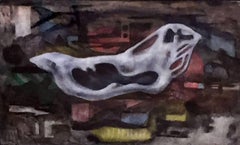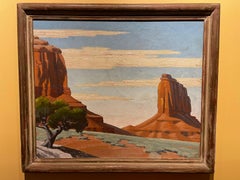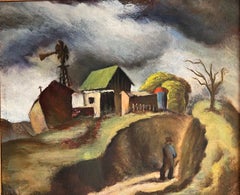Dickson Reeder Art
American, 1912-1970
Edward Dickson Reeder began his art education under Sallie Blyth Mummert and Sallie Gillespie before attending the Art Students League of New York in New York. He later traveled to Europe and studied with Stanley William Hayter at Atelier 17. Reeder and his wife, Flora Blanc, established and directed the Reeder School of Theater and Design in Fort Worth, Texas.
to
1
1
1
Overall Height
to
Overall Width
to
1
1
1
1
1
6,910
3,230
2,514
1,217
1
1
Artist: Dickson Reeder
"Floating" Mid Century Modern Fort Worth Texas Artist
By Dickson Reeder
Located in San Antonio, TX
Dickson Reeder (1912 - 1970) Fort Worth Artist Image Size: 10 x 15 Frame Size: 17 x 22 Medium: Oil on Board Mid Century Modern
Biography
Dickson Reeder (1912 - 1970)
Edward Dickson Reeder began his art education under Sallie Blyth Mummert and Sallie Gillespie before attending the Art Students' League in New York. He later traveled to Europe and studied with Stanley William Hayter at Atelier 17.
Dickson Reeder and his wife, Flora Blanc, established and directed the Reeder School of Theater and Design in Fort Worth (1946-1958).
Please view my 1stdibs store front for other Great Vintage Texas Paintings...
Category
1960s Modern Dickson Reeder Art
Materials
Oil
Related Items
Vintage Modernist Landscape Painting, Monument Valley Arizona, listed artist
Located in Baltimore, MD
Although born in Ohio at the end of the 19th century, Martin Sabransky studied art at Randolph Macon College in Virginia. He began his career path moving west, by first going to Kans...
Category
Mid-20th Century American Modern Dickson Reeder Art
Materials
Oil
Landscape
By Marcel Emile Cailliet
Located in Los Angeles, CA
Landscape, 1940, oil on canvas, 24 x 20 inches, signed, dated and titled verso: “Marcel Cailliet ’40 – S.C.” and “Marcel Cailliet Landscape”; likely exhibited at the annual juried st...
Category
1940s American Modern Dickson Reeder Art
Materials
Canvas, Oil
Figurative landscape oil painting- Purple Memory
Located in Beijing, CN
Dai Xiangwen was born in Hunan in 1991 and graduated from the Academy of Fine Arts of Jianghan University,
He is a member of China Artists Association, China Designers Association, a painter of Li Keran...
Category
2010s Modern Dickson Reeder Art
Materials
Canvas, Oil
Free Shipping
H 23.63 in W 31.5 in
The Old Monastery Wall
By William S. Schwartz
Located in New York, NY
Signed (at lower left): WILLIAM S. SCHWARTZ
Category
Early 20th Century American Modern Dickson Reeder Art
Materials
Canvas, Oil
The Little House in Provence Signed Original French Modernist Oil Painting
Located in Cirencester, Gloucestershire
"Le Mas"
French Modernist artist, 21st century
indistinctly signed lower corner
oil on canvas, framed
framed: 21.5 x 25.5 inches
canvas: 15 x 18 inches
provenance: private collection...
Category
2010s Modern Dickson Reeder Art
Materials
Canvas, Oil
Venice
By Mykola Krychevsky
Located in Bayonne, NJ
A beautiful oil on canvas painting by Mykola Krychevsky depicting St. Mark's Square in Venice. The artist would spent every August painting different city scenes at famous architectu...
Category
20th Century Modern Dickson Reeder Art
Materials
Oil
20th Century French Modernist Signed Oil Boats Moored on Beach
Located in Cirencester, Gloucestershire
Beached Boats
by Lucien Gondret (French b. 1941)
signed oil painting on canvas, unframed
canvas: 18.5 x 22 inches
provenance: private collection, France
condition: very good and soun...
Category
Late 20th Century Modern Dickson Reeder Art
Materials
Oil
Autumn Aspen Forest
By Oscar Edmund Berninghaus
Located in New York, NY
Signed and dated lower right: O.E. BERNINGHAUS. / –49–
Category
20th Century American Modern Dickson Reeder Art
Materials
Oil
Alushta, Crimea
Located in Bayonne, NJ
A tiny oil on card painting that Vasyl Hryhorovych Krychevsky (1872-1952) created in 1935 in Crimea, Ukraine. V.H.Krychevsky is one of the founders of the Ukrainian Art Academy in Ky...
Category
1930s Modern Dickson Reeder Art
Materials
Oil
San Pedro Harbor
By Paul Sample
Located in New York, NY
It is infrequent, to say the least, that a diagnosis of tuberculosis proves fortuitous, but that was the event, in 1921, that set Paul Starrett Sample on the road to becoming a professional artist. (The best source for an overview of Sample’s life and oeuvre remains Paul Sample: Painter of the American Scene, exhib. cat., [Hanover, New Hampshire: Hood Museum of Art, 1988] with a detailed and definitive chronology by Sample scholar, Paula F. Glick, and an essay by Robert L. McGrath. It is the source for this essay unless otherwise indicated.) Sample, born in Louisville, Kentucky, in 1896 to a construction engineer and his wife, spent his childhood moving with his family to the various locations that his father’s work took them. By 1911, the family had landed in Glencoe, Illinois, settling long enough for Paul to graduate from New Trier High School in 1916. Sample enrolled at Dartmouth College, in Hanover, New Hampshire, where his interests were anything but academic. His enthusiasms included the football and basketball teams, boxing, pledging at a fraternity, and learning to play the saxophone. After the United States entered World War I, Sample, to his family’s dismay, signed on for the Naval Reserve, leading directly to a hiatus from Dartmouth. In 1918 and 1919, Sample served in the U.S. Merchant Marine where he earned a third mate’s license and seriously contemplated life as a sailor. Acceding to parental pressure, he returned to Dartmouth, graduating in 1921. Sample’s undergraduate life revolved around sports and a jazz band he formed with his brother, Donald, two years younger and also a Dartmouth student. In November 1933, Sample summarized his life in a letter he wrote introducing himself to Frederick Newlin Price, founder of Ferargil Galleries, who would become his New York art dealer. The artist characterized his undergraduate years as spent “wasting my time intensively.” He told Price that that “I took an art appreciation course and slept thru it every day” (Ferargil Galleries Records, circa 1900–63, Archives of American Art, Smithsonian Institution, available on line).
In 1920, Donald Sample contracted tuberculosis. He went for treatment to the world-famous Trudeau Sanitorium at Saranac Lake, in New York State’s Adirondack Mountains for the prescribed regimen of rest, healthful food, and fresh air. Visiting his brother in 1921, Paul also contracted the disease. Tuberculosis is highly contagious, and had no certain cure before the development of streptomycin in 1946. Even for patients who appeared to have recovered, there was a significant rate of recurrence. Thus, in his letter to Price, Sample avoided the stigma conjured by naming the disease, but wrote “I had a relapse with a bad lung and spent the next four years hospitalized in Saranac Lake.” The stringent physical restrictions imposed by adherence to “the cure” required Sample to cultivate an alternate set of interests. He read voraciously and, at the suggestion of his physician, contacted the husband of a fellow patient for instruction in art. That artist, then living in Saranac, was Jonas Lie (1880–1940), a prominent Norwegian-American painter and an associate academician at the National Academy of Design. Lie had gained renown for his dramatic 1913 series of paintings documenting the construction of the Panama Canal (The Metropolitan Museum of Art, New York; United States Military Academy, West Point, New York). Primarily a landscape artist, Lie had a particular affinity for scenes with water. His paintings, impressionistic, atmospheric, and brushy, never strayed from a realistic rendering of his subject. Sample regarded Lie as a mentor and retained a lifelong reverence for his teacher. Sample’s early paintings very much reflect Lie’s influence.
`
In 1925, “cured,” Sample left Saranac Lake for what proved to be a brief stay in New York City, where his veteran’s benefits financed a commercial art course. The family, however, had moved to California, in the futile hope that the climate would benefit Donald. Sample joined them and after Donald’s death, remained in California, taking classes at the Otis Art Institute in Los Angeles. In Sample’s account to Price, “I couldn’t stomach the practice of painting a lot of High Sierras and desert flowers which seemed to be the only kind of pictures that were sold here so I got a job teaching drawing and painting at the art school of the University of Southern California.” Initially hired as a part-time instructor, Sample progressed to full-time status and ultimately, by the mid-1930s, to the post of Chairman of the Fine Art Department. Sample, however, did not want to wind up as a professor. “Teaching is all right in small doses,” he wrote, “but I have a horror of drifting into being a college professor and nothing more.” At the same time as he taught, Sample began to exhibit his work in a variety of venues at first locally, then nationally. Though he confessed himself “a terrible salesman,” and though occupied with continued learning and teaching, Sample was nonetheless, ambitious. In 1927, he wrote in his diary, “I am eventually going to be a painter and a damned good one. And what is more, I am going to make money at it” (as quoted by Glick, p. 15). In 1928, Sample felt sufficiently solvent to marry his long-time love, Sylvia Howland, who had also been a patient at Saranac Lake. The Howland family were rooted New Englanders and in summertime the Samples regularly traveled East for family reunion vacations.
While the 1930s brought serious hardship to many artists, for Paul Sample it was a decade of success. Buttressed by the financial safety net of his teacher’s salary, he painted realist depictions of the American scene. While his work addressed depression-era conditions with a sympathetic eye, Sample avoided the anger and tinge of bitterness that characterized much contemporary realist art. Beginning in 1930, Sample began to exhibit regularly in juried exhibitions at important national venues, garnering prizes along the way. In 1930, Inner Harbor won an honorable mention in the Annual Exhibition of the Art Institute of Chicago. That same year Sample was also represented in a show at the Albright-Knox Gallery in Buffalo and at the Biennial Exhibition of the Corcoran Gallery of Art, Washington, D.C. In 1931, Dairy Ranch won the second Hallgarten Prize at the Annual Exhibition of the National Academy of Design, in New York. Sample also made his first appearances at the Carnegie Institute, Pittsburgh, and The Pennsylvania Academy of the Fine Arts, Philadelphia. In 1936, Miner’s Resting won the Temple Gold Medal at the Pennsylvania Academy’s Annual Exhibition. Always interested in watercolor, in 1936, Sample began to send works on paper to exhibitions at the Whitney Museum, New York.
While participating in juried exhibitions, Sample also cultivated commercial possibilities. His first New York art dealer was the prestigious Macbeth Gallery in New York, which included his work in a November 1931 exhibition. In 1934, Sample joined the Ferargil Galleries in New York, after Fred Price arranged the sale of Sample’s Church Supper to the Michele and Donald D’Amour Museum of Fine Arts in Springfield, Massachusetts. In 1937, The Metropolitan Museum of Art purchased Sample’s Janitor’s Holiday from the annual exhibition of the National Academy of Design, a notable honor.
As prestigious as this exhibition schedule may have been, by far Sample’s most visible presence in the 1930s and 1940s was the result of his relationship with Henry Luce’s burgeoning publishing empire, Time, Inc. Sample’s first contribution to a Luce publication appears to have been another San Pedro...
Category
20th Century American Modern Dickson Reeder Art
Materials
Canvas, Oil
Suburbs of Paris
By Mykola Krychevsky
Located in Bayonne, NJ
Mykola Krychevsky created this landscape when he first arrived in Paris and lived in its suburbs. It is oil on canvas board, signed lower right. The artist at that time was in his fo...
Category
1930s Modern Dickson Reeder Art
Materials
Oil
Winter on the Farm
By Dale Nichols
Located in New York, NY
Signed and dated lower left: DALE NICHOLS ∙ 1961
Category
20th Century American Modern Dickson Reeder Art
Materials
Oil
Previously Available Items
"Geraldine Smaragderine" Turquoise Expressionist Abstract Painting
By Dickson Reeder
Located in Houston, TX
Lovely turquoise expressionist abstract painting by Texas artist Dickson Reeder. Oil on Canvas painting, titled "Geraldine Smaragderine", and dated 1960. Signed and dated in lower right corner. Hung in a silver frame.
Artist Biography:
Edward Dickson Reeder, artist, was born on February 6, 1912, in Fort Worth, the first child of Dean W. and Edwina (Dickson) Reeder. He began to study drawing and painting with Sallie Blythe Mummert and Sallie Gillespie while still in elementary school. After graduating from Central (later Paschal) High School in Fort Worth in 1930, he left for two years of study at the Art Students League in New York City, where he attended the classes of portraitist Ivan Olinsky, among others. Reeder returned to Fort Worth for a year and in 1933 traveled to Taxco, Guerrero, Mexico, where he studied with the portrait painter Wayman Adams. In the mid-1930s Reeder traveled and worked in Ireland, London, and Paris. During this period he began to exhibit his work by participating in the Southern States Art League exhibitions in 1934, 1938, and 1939 and the Biennial at the Corcoran Gallery of Art in 1939. In Paris he studied abstract painting with Alexandra Exter, who also designed for the Ballet Russe. In 1937 he met Flora Blanc, an artist working with Fernand Leger, and together they studied printmaking at Atelier 17, a workshop run by Stanley William Hayter that was frequented by Pablo Picasso, Marc Chagall, Max Ernst, and Joan Miró.
On December 11, 1937, Flora Blanc and Dickson Reeder were married in New York City. They lived in the Chelsea district painting and illustrating books until 1940, when they moved to Fort Worth. There Reeder painted and taught, first at Texas Wesleyan College and later at Our Lady of Victory...
Category
1960s Abstract Expressionist Dickson Reeder Art
Materials
Oil
H 31 in W 26 in D 2.25 in
Dickson Reeder art for sale on 1stDibs.
Find a wide variety of authentic Dickson Reeder art available for sale on 1stDibs. You can also browse by medium to find art by Dickson Reeder in oil paint, paint and more. Much of the original work by this artist or collective was created during the 1960s and is mostly associated with the modern style. Not every interior allows for large Dickson Reeder art, so small editions measuring 22 inches across are available. Customers who are interested in this artist might also find the work of Harold Vincent Skene, Daniel Brennan, and Mane Katz. Dickson Reeder art prices can differ depending upon medium, time period and other attributes. On 1stDibs, the price for these items starts at $3,800 and tops out at $3,800, while the average work can sell for $3,800.


